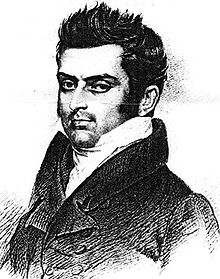- Clarke Abel
-
Clarke Abel (c. 1789 – c. 24 November 1826) was a British surgeon and naturalist.
He accompanied Lord Amherst on his mission to China in 1816-17 as the embassy's chief medical officer and naturalist, on the recommendation of Sir Joseph Banks. The mission was Britain's second unsuccessful attempt to establish diplomatic relations with China and involved travelling to the capital Pekin (Beijing) and the famous botanical gardens of Fa Tee near Canton. While in China, Abel collected specimens and seeds of the plant that carries his name, Abelia chinensis, described by Banks' botanical secretary Robert Brown, "with friendly partiality". However a shipwreck and an attack by pirates on the way back to his home in Britain caused him to lose all of his specimens. Abel's Narrative of a Journey in the Interior of China, 1818, gives a detailed account of the collection's misfortunes.< Fortunately, he had left some specimens with sir George Staunton at Canton, who was kind enough to return them to him; living specimens of the Chinese Abelia that we know today were introduced by Robert Fortune in 1844.[1].
In March, 1819 he was elected a Fellow of the Royal Society[2] He was also a member of the Geological Society.[3]
Abel was the first Western scientist to report the presence of orangutan on the island of Sumatra. He went on to become the surgeon-in-chief to Lord Amherst when the earl was appointed Governor-general of India. Abel died at Cawnpore, India, 24 November 1826, aged 37.
References
- ^ Alice M. Coats, Garden Shrubs and Their Histories (1964) 1992, s.v. "Abelia".
- ^ "Library and Archive Catalogue". Royal Society. http://www2.royalsociety.org/DServe/dserve.exe?dsqIni=Dserve.ini&dsqApp=Archive&dsqCmd=Show.tcl&dsqDb=Persons&dsqPos=0&dsqSearch=%28Surname%3D%27abel%27%29. Retrieved 5 December 2010.
- ^ According to the title page of his Narrative 1818.
- ^ "Author Query". International Plant Names Index. http://www.ipni.org/ipni/authorsearchpage.do.
- Diana Wells, 100 Flowers and How They Got their Names, (Chapel Hill: Algonquin), 1997.

This United Kingdom biographical article related to medicine is a stub. You can help Wikipedia by expanding it.

